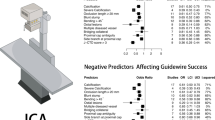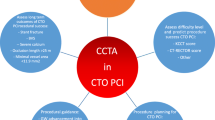Abstract
Chronic total occlusions of coronary arteries occur in about 20 % of patients with suspected coronary artery disease and are more frequent with increasing age. The success rate of interventions is lower (55–80 %) compared to conventional lesions (>90 %). Coronary CT angiography (coronary CTA) provides information about the occluded segment, which cannot be obtained from invasive angiograms (XA). We therefore hypothesized that preprocedural coronary CTA may improve success rates of percutaneous coronary intervention (PCI) for coronary arteries (CTO). 30 patients with chronic total coronary artery occlusions (mean age 73 years, 26 men) and predicted high complexity were imaged by coronary CTA prior to PCI for CTO. CT data sets were acquired with a 64 detector row dual source scanner and retrograde ECG gating, 0.6 mm collimation and z-flying focal spot, yielding isovoxel spatial resolution of about 0.4 mm. Based on the CT data sets, established complexity criteria for CTO (Euro CTO club, Di Mario et al. in EuroIntervention 3(1):30–43, 2007) were evaluated and compared to invasive coronary angiography. Three-dimensional volume-rendered images of the occluded coronary artery were displayed in the catheterization lab during PCI to guide the advancement of the wire. PCI success, defined as the ability to advance the guide wire into the distal lumen with thrombolysis in myocardial infarction III flow was compared to 43 controls without coronary CTA using propensity score matching based on established criteria of procedural success. The course of the occluded segments was visualized by coronary CTA in all cases. Calcification, lesion length, stump morphology and presence of side branches were underestimated by invasive angiograms when compared to coronary CTA. PCI success rate in 30 patients who underwent pre-procedural CTA was significantly higher than in patients without prior coronary CTA [unmatched: CT 90 % (27/30) vs. no CT 63 % (27/43), p = 0.009; matched: CT 88 % (22/25) vs. no CT 64 % (16/25) p = 0.03]. Through information not readily seen on invasive coronary angiography, coronary CTA can significantly enhance success rates of PCI for CTO.


Similar content being viewed by others
References
Fefer P, Knudtson ML, Cheema AN, Galbraith PD, Osherov AB, Yalonetsky S et al (2012) Current perspectives on coronary chronic total occlusions: the canadian multicenter chronic total occlusions registry. J Am Coll Cardiol 59(11):991–997
Cohen HA, Williams DO, Holmes DR Jr, Selzer F, Kip KE, Johnston JM et al (2003) Impact of age on procedural and 1-year outcome in percutaneous transluminal coronary angioplasty: a report from the NHLBI Dynamic Registry. Am Heart J 146(3):513–519
Hoe J (2009) CT coronary angiography of chronic total occlusions of the coronary arteries: how to recognize and evaluate and usefulness for planning percutaneous coronary interventions. Int J Cardiovasc Imaging 25(Suppl 1):43–54
Stone GW, Kandzari DE, Mehran R, Colombo A, Schwartz RS, Bailey S et al (2005) Percutaneous recanalization of chronically occluded coronary arteries: a consensus document: part I. Circ Cardiovasc Imaging. 112(15):2364–2372
DiMario C, Werner G, Sianos G, Galassi A, Büttner J, Dudek D et al (2007) European perspective in the recanalisation of Chronic Total Occlusions (CTO): consensus document from the EuroCTO Club. EuroIntervention 3:30–43
Suero JA, Marso SP, Jones PG, Laster SB, Huber KC, Giorgi LV et al (2001) Procedural outcomes and long-term survival among patients undergoing percutaneous coronary intervention of a chronic total occlusion in native coronary arteries: a 20-year experience. J Am Coll Cardiol 38(2):409–414
Olivari Z, Rubartelli P, Piscione F, Ettori F, Fontanelli A, Salemme L et al (2003) Immediate results and one-year clinical outcome after percutaneous coronary interventions in chronic total occlusions: data from a multicenter, prospective, observational study (TOAST-GISE). J Am Coll Cardiol 41(10):1672–1678
Stone GW, Reifart NJ, Moussa I, Hoye A, Cox DA, Colombo A et al (2005) Percutaneous recanalization of chronically occluded coronary arteries: a consensus document: part II. Circ Cardiovasc Imaging 112(16):2530–2537
Mehran R, Claessen BE, Godino C, Dangas GD, Obunai K, Kanwal S et al (2011) Long-term outcome of percutaneous coronary intervention for chronic total occlusions. JACC Cardiovasc Interv 4(9):952–961
Galassi AR, Tomasello SD, Reifart N, Werner GS, Sianos G, Bonnier H et al (2011) In-hospital outcomes of percutaneous coronary intervention in patients with chronic total occlusion: insights from the ERCTO (European Registry of Chronic Total Occlusion) registry. EuroIntervention 7(4):472–479
Soon KH, Selvanayagam JB, Cox N, Kelly AM, Bell KW, Lim YL (2007) Percutaneous revascularization of chronic total occlusions: review of the role of invasive and non-invasive imaging modalities. Int J Cardiol 116(1):1–6
Joyal D, Afilalo J, Rinfret S (2010) Effectiveness of recanalization of chronic total occlusions: a systematic review and meta-analysis. Am Heart J 160(1):179–187
Noguchi T, Miyazaki MS, Morii I, Daikoku S, Goto Y, Nonogi H (2000) Percutaneous transluminal coronary angioplasty of chronic total occlusions. Determinants of primary success and long-term clinical outcome. Catheter Cardiovasc Interv 49(3):258–264
Tan KH, Sulke N, Taub NA, Watts E, Karani S, Sowton E (1993) Determinants of success of coronary angioplasty in patients with a chronic total occlusion: a multiple logistic regression model to improve selection of patients. Br Heart J 70(2):126–131
Di Mario C, Werner GS, Sianos G, Galassi AR, Buttner J, Dudek D et al (2007) European perspective in the recanalisation of Chronic Total Occlusions (CTO): consensus document from the EuroCTO Club. EuroIntervention 3(1):30–43
Mollet NR, Hoye A, Lemos PA, Cademartiri F, Sianos G, McFadden EP et al (2005) Value of preprocedure multislice computed tomographic coronary angiography to predict the outcome of percutaneous recanalization of chronic total occlusions. Am J Cardiol 95(2):240–243
Otsuka M, Sugahara S, Umeda K, Nakamura M, Nakamura A, Bonkohara Y et al (2008) Utility of multislice computed tomography as a strategic tool for complex percutaneous coronary intervention. Int J Cardiovasc Imaging 24(2):201–210
Kaneda H, Saito S, Shiono T, Miyashita Y, Takahashi S, Domae H (2007) Sixty-four-slice computed tomography-facilitated percutaneous coronary intervention for chronic total occlusion. Int J Cardiol 115(1):130–132
Yokoyama N, Yamamoto Y, Suzuki S, Suzuki M, Konno K, Kozuma K et al (2006) Impact of 16-slice computed tomography in percutaneous coronary intervention of chronic total occlusions. Catheter Cardiovasc Interv 68(1):1–7
Garcia–Garcia HM, van Mieghem CA, Gonzalo N, Meijboom WB, Weustink AC, Onuma Y et al (2009) Computed tomography in total coronary occlusions (CTTO registry): radiation exposure and predictors of successful percutaneous intervention. EuroIntervention 4(5):607–616
Soon KH, Cox N, Wong A, Chaitowitz I, Macgregor L, Santos PT et al (2007) CT coronary angiography predicts the outcome of percutaneous coronary intervention of chronic total occlusion. J Interv Cardiol 20(5):359–366
Austin PC (2008) A critical appraisal of propensity-score matching in the medical literature between 1996 and 2003. Stat Med 27(12):2037–2049
Leuven E, Sianesi B (2010) PSMATCH2: stata module to perform full Mahalanobis and propensity score matching, common support graphing and covariate imbalance testing. 4.0.4. Nov 2010 ed2003
Schwartz RS, Cardiac CTA (2008) three-dimensions, and the chronic total occlusion: a window to the future. Catheter Cardiovasc Interv 71(6):790–791
Hecht HS (2008) Applications of multislice coronary computed tomographic angiography to percutaneous coronary intervention: how did we ever do without it? Catheter Cardiovasc Interv 71(4):490–503
Puma JA, Sketch MH Jr, Tcheng JE, Harrington RA, Phillips HR, Stack RS et al (1995) Percutaneous revascularization of chronic coronary occlusions: an overview. J Am Coll Cardiol 26(1):1–11
Dong S, Smorgick Y, Nahir M, Lotan C, Mosseri M, Nassar H et al (2005) Predictors for successful angioplasty of chronic totally occluded coronary arteries. J Interv Cardiol 18(1):1–7
Morino Y, Abe M, Morimoto T, Kimura T, Hayashi Y, Muramatsu T et al (2011) Predicting successful guidewire crossing through chronic total occlusion of native coronary lesions within 30 minutes: the J-CTO (Multicenter CTO Registry in Japan) score as a difficulty grading and time assessment tool. JACC Cardiovasc Interv 4(2):213–221
Tomasello SD, Costanzo L, Campisano MB, Barrano G, Capodanno D, Tamburino C et al (2011) Does occlusion duration influence procedural and clinical outcome of patients who underwent percutaneous coronary intervention for chronic total occlusion? J Interv Cardiol 24(3):223–231
Conflict of interest
None.
Author information
Authors and Affiliations
Corresponding author
Rights and permissions
About this article
Cite this article
Rolf, A., Werner, G.S., Schuhbäck, A. et al. Preprocedural coronary CT angiography significantly improves success rates of PCI for chronic total occlusion. Int J Cardiovasc Imaging 29, 1819–1827 (2013). https://doi.org/10.1007/s10554-013-0258-y
Received:
Accepted:
Published:
Issue Date:
DOI: https://doi.org/10.1007/s10554-013-0258-y




